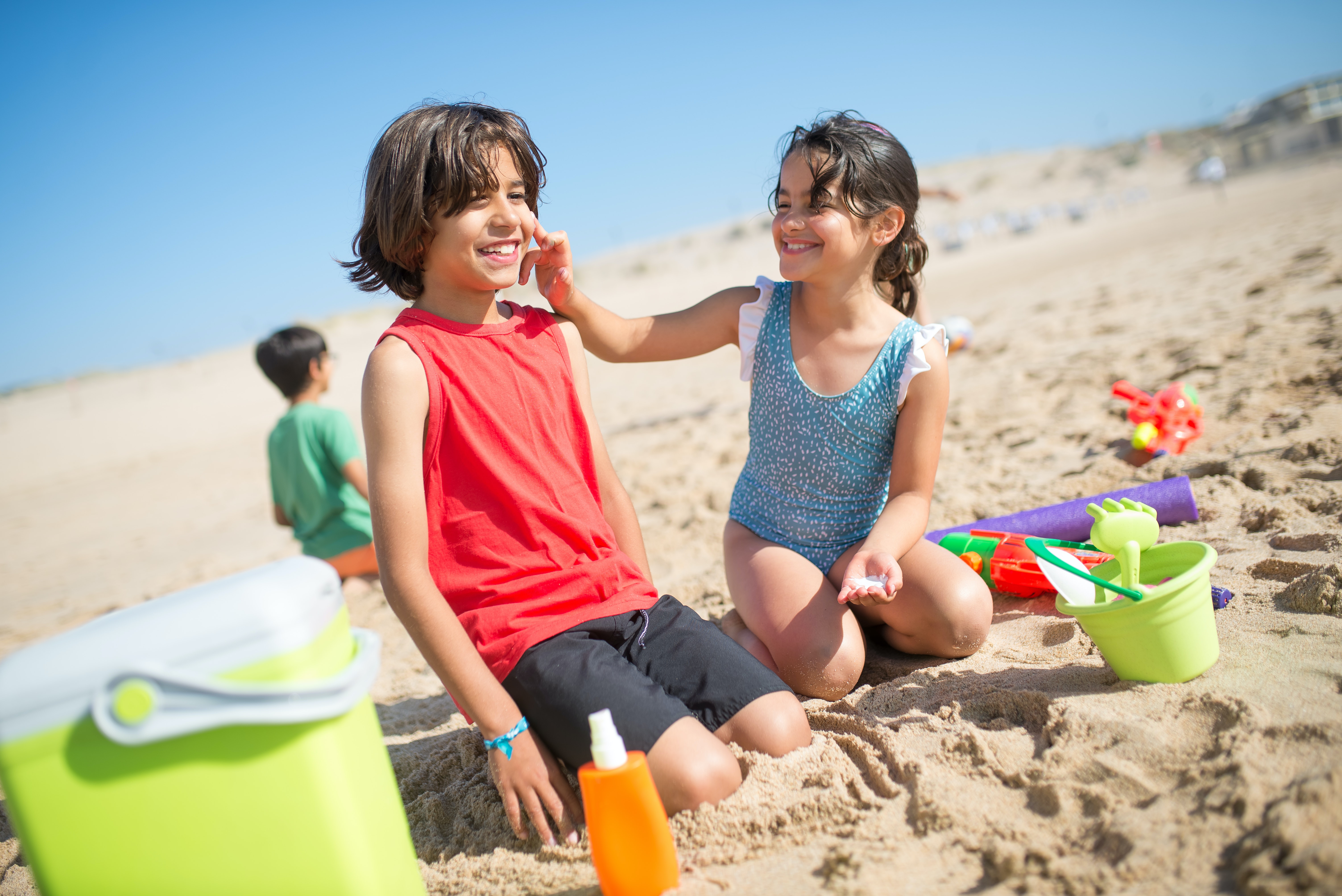Sun Care for Kids: What’s Hot and What’s Not? Tips on Protecting Your Little Ones from Harmful Rays

The heat of Summer is here which means beaches along the Costa del sol are beckoning. As parents, it’s important to ensure that our children are protected from the harmful effects of the sun’s rays. Sunburn can increase the risk of skin cancer, and even a tan doesn’t provide adequate protection. So, how can we strike a balance between allowing our kids to enjoy the outdoors and keeping them safe from the sun? In this comprehensive guide, we’ll explore the best practices for sun care for kids, including sunscreen selection, sun safety tips, and more. Let’s dive in and learn how to keep our little ones protected and happy under the sun.
The Importance of Sun Protection for Kids
Sun care for kids is of utmost importance, as their delicate skin is more susceptible to sunburn and long-term damage. Even on cloudy days or in cooler climates, UV rays can still penetrate the skin and cause harm. Sunburn in childhood is known to increase the risk of skin cancer later in life, making it vital to establish sun protection habits from an early age.
When Should Children Start Wearing Sun Cream?
Determining the right age for children to start wearing sunscreen can be a bit tricky. While sun exposure is essential for vitamin D synthesis, protecting children from harmful UV rays is critical. According to experts, infants under six months should avoid direct sun exposure altogether. For children aged one year and older, using sunscreen with at least SPF 30 is recommended.
The Sun Protection Factor (SPF) and Its Importance
When selecting a sun cream for your child, it’s essential to consider the sun protection factor (SPF). SPF measures the level of protection against UVB radiation, which causes sunburn. The higher the SPF, the more protection it provides. Experts recommend choosing a sunscreen with SPF 30 or higher for children. Additionally, look for sun creams that offer broad-spectrum protection, shielding against both UVA and UVB rays.
Choosing the Right Sun Cream for Kids
With numerous sunscreen options available, it can be overwhelming to find the best one for your child. Here are some factors to consider when choosing the best form of sun protection:
- SPF Level: Select a sun block with SPF 30 or higher to ensure adequate protection.
- Broad-Spectrum: Look for sunscreens that offer protection against both UVA and UVB rays.
- Water Resistance: Opt for a water-resistant sun cream if your child will be swimming or sweating.
- Skin Sensitivity: If your child has sensitive skin, choose a sunscreen specifically formulated for sensitive skin types.
- Hypoallergenic: Consider hypoallergenic sun creams to minimise the risk of allergic reactions.
Applying Sunscreen: Tips and Tricks
Proper application of sunscreen is important for optimal sun protection. Here are some tips to ensure your child is adequately protected:
- Amount: Apply a generous amount of sunscreen to cover all exposed areas of your child’s skin.
- Timing: Apply sun cream at least 30 minutes before sun exposure to allow it to absorb into the skin.
- Reapplication: Reapply sunblock every two hours, or immediately after swimming/excessive sweating.
- Coverage: Ensure sunscreen is applied to all exposed areas, including the face, ears, neck, and hands.
- Lip Protection: Don’t forget to protect your child’s lips with an SPF 30 or higher lip balm.
Sun Safety Tips for Kids
In addition to using sunscreen, there are other sun safety measures you can take to protect your child from harmful UV rays. Here are some sun safety tips for kids:
- Seek Shade: Encourage your child to spend time in the shade, especially during hours of peak sun between 12 pm and 4 pm.
- Cover Up: Dress your child in lightweight, breathable clothing. Be careful to cover their arms, legs, and neck.
- Sun Hats: Opt for wide-brimmed hats to shade your child’s face, neck, and ears.
- Sunglasses: Protect your child’s eyes by providing them with sunglasses that offer UV protection.
- Seek Indoor Activities: Plan outdoor activities during non-peak sun hours or elect for indoor activities such as soft play sessions booked privately at Intooit Kids Play Club.

Best Sunblock for Kids
Now that we understand the importance of sun care for kids, let’s explore some of the best sunscreens available on the market. These selected formulations provide effective sun protection while being gentle on your child’s delicate skin.
- Ultrasun 50+ Kids Sunscreen
Ultrasun 50+ Kids Sunscreen is a top choice for children with sensitive skin. This sun cream offers powerful sun protection with SPF 50+ and 95% UVA protection. The formula is gentle, non-greasy, and suitable for use from birth. It also contains Celligent®, an active ingredient that neutralizes free radicals to prevent skin cell damage. Though it may be a bit sticky, its effectiveness and suitability for sensitive skin make it a great option for kids.
- La Roche-Posay’s Anthelios Child-Friendly Sunscreen
La Roche-Posay’s Anthelios Dermo-Pediatrics Invisible Spray SPF50+ Child-Friendly Sunscreen is another excellent choice for adequate sun care. This sunscreen provides broad-spectrum protection against UVA and UVB rays. Its water-resistant formula ensures long-lasting protection, even during water activities. The gentle formula is suitable for children’s sensitive skin and is free from harsh chemicals. With its easy application and effective sun protection, [Insert brand name] Kids Sunblock is a reliable option for all-day sun protection.
- Suntribe Kids and Mineral Sunblock
Suntribe Kids and Mineral SPF 30 Kids Sunblock is specially formulated to provide high sun protection using only natural ingredients like Coconut oil and Vitamin E oil. With its SPF 30 non-nano mineral UV-filters, this sun cream shields your child’s skin from harmful rays while being reef-friendly and cruelty-free. The lightweight and non-greasy formula makes for a smooth application and easy wear for children of the more eco-conscious. Suntribe Kids and Mineral Sun cream is an excellent choice for parents looking for a reliable, natural, and gentle sunscreen for their kids.
Sun Safety Beyond Sunscreen
While sunscreen is a crucial part of sun care for kids, there are other measures you can take to ensure their safety under the sun. Here are some additional tips to keep in mind:
- Protective Clothing
Alongside sunscreen, dressing your child in protective clothing can enhance their level of protection from the sun. Lightweight, breathable fabrics that cover their arms, legs, and neck are strongly recommended, especially for those with more delicate skin types. Specialised clothes with a high Ultraviolet Protection Factor (UPF) is also a sensible option, especially for those on holiday who might find themselves in climates unfamiliar to delicate younger skin.
- UV-Protective Accessories
Accessories like sun hats and sunglasses can provide additional protection for your child. Choose wide-brimmed hats that shade their face, neck, and ears. Sunglasses with UV protection shield their eyes from damaging sun rays on reflective surfaces like water or light-coloured sand.
- Stay Hydrated
Encourage your child to drink plenty of water, especially when spending time outdoors in the sun. Staying hydrated helps regulate body temperature and prevents dehydration.
- Seek Shade
Whenever possible, seek shade during the peak sun hours between 12 pm and 4 pm. Shade provides a natural barrier from direct sunlight and can help reduce the risk of sunburn.
- Lead by Example
Teach your child about sun safety by setting a good example. Apply sun cream to yourself and demonstrate the importance of sun protection. Children are more likely to adopt healthy habits when they see their parents practicing them.
Conclusion
Sun care for kids is a vital aspect of ensuring their overall health and well-being, especially during the summer months when family holidays abroad are more likely and children are naturally inspired to spend more time in the sun. By following sun safety guidelines, choosing the right sunscreen, and incorporating additional protective measures, you can provide your child with the tools they need to safely enjoy warm and sunny weather. Remember to apply sunscreen generously and reapply regularly, seek shade, and encourage your child to wear protective clothing and accessories. With these precautions in place, you can make the most of the summer months, and on the days when a retreat from the heat is called for, consider a private party or play day at Intooit Kids Club!
Disclaimer: The information provided in this article is for educational purposes only and should not replace professional medical advice. Always consult with a healthcare provider for personalized recommendations and guidance regarding sun care for kids.







Leave A Comment